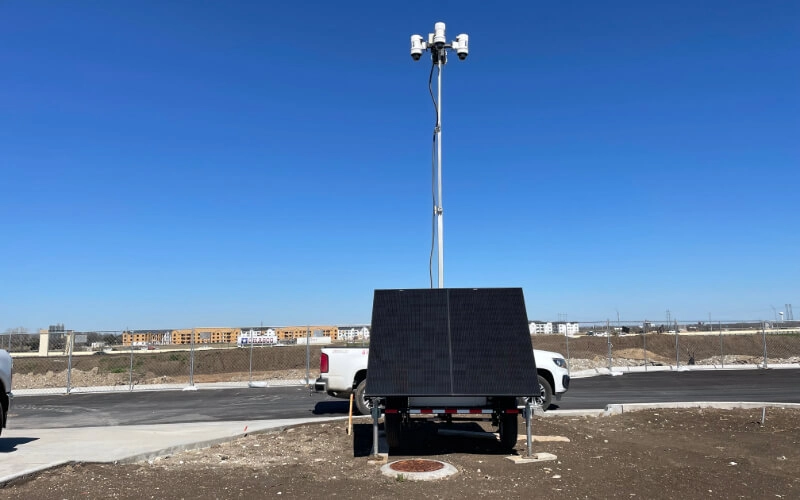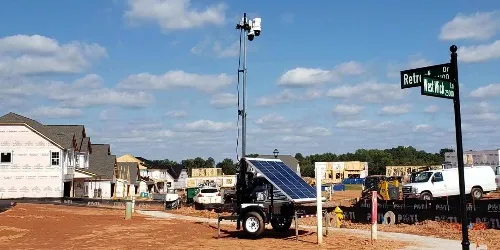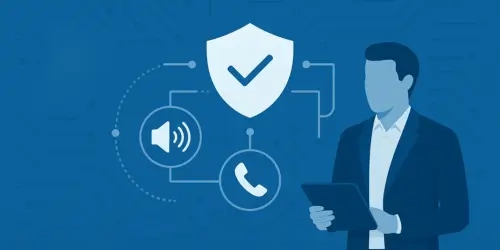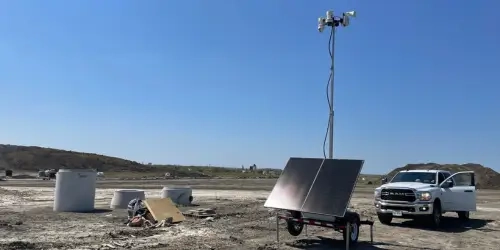Construction jobsites rely on a wide range of tools every day, each playing a role in keeping workers safe and operations on track. But when these systems work in isolation, important information gets lost between them.
Logging into separate systems, checking multiple dashboards, and manually connecting information from different sources causes delays between detection and response, which modern construction jobsites can't afford.
An integrated system solves this problem by bringing security, monitoring, and communication tools under one coordinated platform. The result? Teams gain a clear understanding of what is happening across their jobsites without missing any important details.
In this article, we break down what exactly counts as "integration" in a construction setting, and why it's quickly becoming vital for smarter, safer jobsites in the US.
What Does an Integrated Security System Mean in Construction?
Security system integration on a construction jobsite is the process of linking separate security and monitoring tools so they operate as a single, coordinated system, allowing construction security to access everything from a unified platform.
Stellifii, our cloud-based platform, connects video, alerts, sensor data, diagnostics, and reporting in a single interface accessible via web and mobile.
Here's what Stellifii brings together in construction environments:
-
Mobile Solar Surveillance Trailers, standing up to 20 feet tall, provide rapid-deployment video security with HD cameras, cellular connectivity, remote access, and live monitoring. They're designed to go live quickly, and basic installations can be set up in under 20 minutes.
-
Pole Cameras add flexible, redeployable coverage for fixed viewpoints. They combine HD video, onboard storage, cellular transmission, remote access, and support for AI analytics without the complexity of permanent installations.
-
Smart Detection Systems run AI analytics to spot PPE non-compliance, human-based intrusions, smoke, and fire hazards, among other important details. They send instant alerts with linked video so teams can verify and act fast. They're software-driven and integrate directly with our Surveillance Trailers and Pole Cameras.
-
Environmental Monitoring Solutions track jobsite conditions that can halt work using IoT-based sensors to monitor air quality, noise, vibration, and weather. They provide real-time readings, thresholds, and reports in the same platform used for video surveillance.
When these elements are connected to a single cloud-based system like Stellifii, information flows quickly and consistently, and teams never miss important details.
Read more:
- The Benefits of Integrating Your Security and Communications Systems
- A Day in the Life of a Connected Site: What Integrated Security Looks Like in Action

4 Reasons Why Integrated Security Solutions Matter for Construction Security
Construction jobsites move quickly, but they also change constantly. When security systems and monitoring tools operate independently, security personnel waste valuable time piecing together what happened rather than addressing problems immediately.
Here's why integration has shifted from a "nice extra" to an essential part of jobsite security plans:
1. Faster response and better situational awareness
One of the biggest benefits of integrated security is speed. By connecting detection tools, cameras, and sensors, each event automatically provides the right context for faster decision-making and response.
Security personnel no longer receive a simple motion alert if there's movement on the perimeter; instead, they'll get:
-
Footage of the nearest camera angle
-
A precise timestamp and location
-
The corresponding event log
With all this information available at once, supervisors can make quick, confident decisions and respond immediately.
Read more: How Smart Security Systems Benefit Construction Jobsites
2. Higher efficiency and less manual oversight
Disconnected and fragmented systems require constant checking, such as:
-
Multiple logins
-
Clicking through tabs
-
Reviewing feeds
-
Pulling reports
-
Stitching together what happened
Integrated security systems handle that work for you in minutes by filtering alerts, organizing camera footage, and centralizing data so your team spends less time digging for information and more time keeping the jobsite secure.
Stellifii gives construction teams a single platform to manage every aspect of the jobsite, streamlining security, safety, compliance, and visibility, without juggling multiple systems or suppliers.
Read more:
-
Cloud vs. On-Premise: What Works Best for Jobsite Safety and Compliance
-
The Importance of Aligning IT and Safety Leaders on Jobsites
3. Better risk management and safer working conditions
When multiple security and monitoring systems communicate, teams can spot problems early. For example:
-
PPE detection flags missing safety gear so supervisors can intervene right away
-
Smoke and fire detection identifies early-stage smoke or flame through AI analytics
-
Intrusion detection filters out false triggers and alerts teams to verified human movement
-
Air quality sensors track dust, gases, and environmental conditions that could affect safety
-
Noise monitoring measures dB levels and alerts teams when readings exceed limits
-
Weather monitoring provides real-time lightning, wind, heat, and rainfall alerts and reports
Integration helps teams catch problems long before they escalate into downtime, injuries, or compliance failures.
Read more: The Growing Expectation of Tech-Enabled Compliance in Construction
4. Smarter long-term planning through centralized data
Integrated security systems monitor what's happening in real-time and also record patterns over time. For example, security officers can analyze data to understand:
-
When metal theft or trespass attempts tend to occur
-
Which zones experience repeated dust spikes
-
How weather patterns affect different stages of construction
With everything funneled into one platform, construction jobsites get long-term insight that would be extremely time-consuming and nearly impossible to gather manually.
Read more:
How Integrated Systems Compare to Non-Integrated Ones
Let's take a closer look at how an integrated security solution compares to a traditional, non-integrated approach:
| System | Non-integrated security system | Integrated security system |
| Day-to-day oversight | Constant check-up of separate dashboards | One centralized view where all systems share data automatically |
| Event awareness | Alerts arrive without context | Alerts arrive with matching video, timestamps, and environmental data |
| Response speed | Slow; supervisors must piece information together first | Fast, due to AI filtering and automatic camera switching |
| Human error | Higher chance of missed alerts or overlooked hazards | Automated workflows keep critical events front and center |
| Environmental safety | Sensors operate independently | Environmental sensors warn managers about dangerous thresholds and health and safety concerns |
| After-hours security | Footage must be reviewed manually | Everything is triggered in one sequence |
| Reporting and compliance | Data is scattered | Data is stored in one place |
| Long-term planning | Trends are difficult to identify manually | Centralized data reveals patterns across jobsites and projects |
| Overall efficiency | Tools work, but rarely together | Systems cooperate, automate, and support a smoother jobsite |
The Cost, Control, and Consistency of an Integrated Security System
Integrated systems deliver measurable value. Our data shows that using mobile surveillance instead of physical security can cut security costs by 88%. Automation handles the routine work (filtering alerts, verifying events, logging data) so teams aren't tied up with manual checks or follow-up.
With all footage and readings stored in Stellifii, reporting takes minutes instead of hours, and long-term trends are easier to analyze.
Read more:
How Stellifii Powers Integrated Intelligence Across Jobsites
Stellifii is our in-house integrated security system that brings all WCCTV systems together, but its value goes far beyond storing data. Here's what integration under Stellifii looks like in day-to-day operations:
A unified view of what's happening on-site
Construction jobsites often have dozens of moving parts, such as access points, active work areas, haul routes, and shifting weather. Stellifii brings these elements together, helping teams answer simple questions faster, such as:
-
What triggered this alert?
-
Who was present at that time?
-
Which conditions were in play when the delay occurred?
Artificial intelligence that filters out the noise
Stellifii doesn't rely on basic motion detection. Instead, it uses AI analytics tied directly to the jobsite's video network. The platform:
-
Identifies intrusions, PPE violations, smoke, and unusual activity
-
Verifies events through live remote monitoring
-
Escalates only what requires attention
An environmental context you can act on immediately
Stellifii links environmental readings with on-site activity so that patterns are easier to interpret:
-
Adjusting work to avoid dust production
-
Halting crane operation in high-speed winds
-
Extreme heat displays in the same dashboard used for crew oversight
One platform instead of multiple suppliers
Because all of our video surveillance cameras, Surveillance Trailers, and sensors connect automatically over 4G/5G, there's:
-
No software installation
-
No complex integrations
-
No multiple vendors to manage
Clear reporting and faster decisions
When detection alerts, video, and environmental data share the same timeline, reporting becomes much simpler. This level of intelligence allows supervisors to:
-
Export relevant footage quickly
-
Pull environmental logs for audits and inspections
-
Build clear paper trails for PPE compliance and/or weather-related delays
Stellifii automatically organizes this information, allowing teams to use it immediately for safety briefings and security risk reviews.
Read more: Stellifii: Our New Smart Platform Transforming Surveillance, Safety, and Compliance
The Future of Integrated Security Systems
Integrated security is becoming a standard expectation across modern construction jobsites, and several trends are shaping the next phase:
-
AI detection is reducing manual oversight
-
Environmental sensors are moving from "nice extras" to essential tools
-
Cloud-based platforms are becoming the preferred way to manage multiple jobsites
-
Automated workflows are replacing siloed systems
-
Consistent visibility across all jobsites is treated like a priority
What we're seeing today represents just the beginning of a larger shift in how jobsites handle safety and security monitoring.
Read more:
-
Why Smart Surveillance Systems Are the Future of Business Security
-
The Future of Construction Security: From Guards to AI-Powered Smart Systems
-
How IT Managers Can Support Hybrid and Remote Construction Safety Management

Integration Is the Future of Smarter, Safer Jobsites
The days of handling disconnected systems are over. Integrated security gives you the clarity, control, and confidence to run a safe and organized construction jobsite.
From weather alerts and AI detections to after-hours protection, everything flows through Stellifii for instant visibility and reliable insight. It's faster, smarter, and built to support the way modern construction works.
Contact us to explore our range of security solutions and see how Stellifii brings them all together.
FAQs
How does integrated security improve overall security on a construction jobsite?
Integrated security systems bring cameras, intrusion detection, IoT-based environmental sensors, and access control into one platform. Supervisors see every alert, video feed, and data point in one place, which strengthens site security, business continuity, and decision-making.
What are the key components of an integrated electronic security system?
A modern security setup combines mobile surveillance, access control systems, AI-driven analytics, alarm systems, and environmental sensors. These security technologies work together to support incident management, restrict access where needed, and provide a more comprehensive approach than traditional security guards alone.




